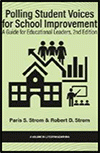
Polling Student Voices for School Improvement
A Guide for Educational Leaders - 2nd Edition
By:
Paris S. Strom, Auburn University
Robert D. Strom, Arizona State University
A volume in the series: Lifespan Learning. Editor(s): Paris S. Strom, Auburn University. Robert D. Strom, Arizona State University.
Published 2024
The purpose of this book is to help secondary school principals and college faculty fulfill their key role for continuous improvement planning of educational practices and safety at their institution. Rapid social and technological advances have motivated the consideration of student voice in schools across the United States. By merging student voice and educator expertise, an intergenerational perspective can emerge that more accurately portrays the strengths and limitations of a school.
Strom and Strom began their research on student voice by partnering with adolescents and principals from several schools to identify topics they saw as appropriate for polling to improve schools. This effort led to the development of ten polls on school stress, career exploration, time management, attention and distraction, tutoring, peer support, school cheating, frustration, cyberbullying, and Internet learning. Every poll contains 15 to 20 multiple-choice items. The process model for polling includes a step-by-step procedure that educational leaders can use to plan and implement school improvement. Different methods of data analysis and ways to report overall evidence-based school results are presented by age, gender, grade and ethnicity. Student polling is distinctive from other assessment strategies because the target for data gathering is a single school, without comparison to other schools. This narrow base to assess student voice ensures poll results are anonymous and have local relevance to guide stakeholder responses.
The results of polling can provide data-based evidence that can be used for continuous education improvement planning. An additional benefit is to separately assess students in special education, gifted and talented programs, and second language acquisition learners. Our web site at learningpolls.org is intended to further inform educational leaders and invite their collaboration.
CONTENTS
Preface: A Guide for Educational Leaders, Paris S. Strom and Robert D. Strom. PART I: MENTAL HEALTH CONDITIONS OF LEARNING. Learning From Students How to Improve Their School, Paris S. Strom, Robert D. Strom, and Charlotte I. Wing. High School Student Stress and School Improvement, Paris S. Strom, Kelli L. Hendon, Robert D. Strom, and Chih-hsuan Wang. Frustration and Self-Control, Paris S. Strom and Robert D. Strom. PART II: IDENTITY AND STATUS CONDITIONS OF LEARNING. Career Exploration and Identity, Paris S. Strom, Robert D. Strom, and Leah S. Whitten. Time Management, Paris S. Strom, Robert D. Strom, and Tricia Sindel-Arrington. Cheating and Values, Paris S. Strom and Robert D. Strom. PART III: COGNITIVE AND ACADEMIC CONDITIONS OF LEARNING. Student Attention and Distraction in Community College, Paris S. Strom, Robert D. Strom, Tricia Sindel-Arrington, and Renée V. Rude. Assessment of Internet Learning for High School Students, Paris S. Strom, Kelli L. Hendon, and Robert D. Strom. Tutoring Support and Student Voice in Middle School, Paris S. Strom, Robert D. Strom, Tricia Sindel-Arrington, and Chih-hsuan Wang. PART IV: SOCIAL AND EMOTIONAL CONDITIONS OF LEARNING. How Peers Support and Inhibit Learning, Paris S. Strom, Kelli L. Hendon, Robert D. Strom, and Chih-hsuan Wang. Cyberbullying and Student Safety, Paris S. Strom, Robert D. Strom, and Julius J. Wingate. Author/Editor Bios.
-
Paperback979-8-88730-438-0
Web price: $45.04 (Reg. 52.99)
-
Hardcover979-8-88730-439-7
Web price: $80.74 (Reg. 94.99)
- eBook979-8-88730-440-3

- EDU032000 - EDUCATION: Leadership
- EDU034000 - EDUCATION: EDUCATIONAL POLICY & REFORM: General
- EDU025000 - EDUCATION: Secondary
-
 Adolescents in the Internet Age
A Team Learning and Teaching Perspective Third Edition
Adolescents in the Internet Age
A Team Learning and Teaching Perspective Third Edition
-
 Adolescents In The Internet Age, 2nd Edition
Teaching And Learning From Them
Adolescents In The Internet Age, 2nd Edition
Teaching And Learning From Them
-
 Adult Learning and Relationships
Adult Learning and Relationships
-
 Learning Throughout Life
An Intergenerational Perspective
Learning Throughout Life
An Intergenerational Perspective
-
 Parenting Young Children
Exploring the Internet, Television, Play, and Reading
Parenting Young Children
Exploring the Internet, Television, Play, and Reading
-
 Polling Students for School Improvement and Reform
Polling Students for School Improvement and Reform
-
 Thinking in Childhood and Adolescence
Thinking in Childhood and Adolescence

